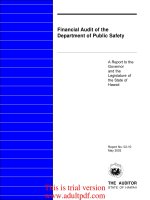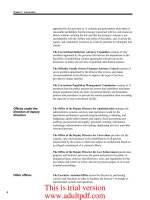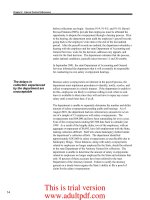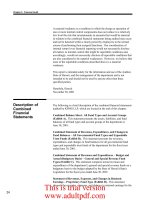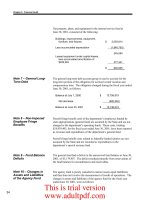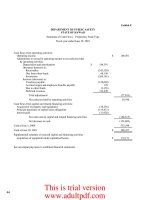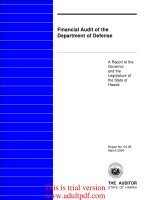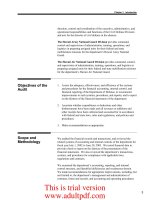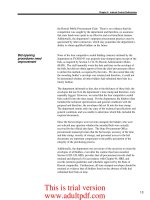Financial Audit of the Department of Defense A Report to the Governor and the Legislature of the State of Hawaii_part2 ppt
Bạn đang xem bản rút gọn của tài liệu. Xem và tải ngay bản đầy đủ của tài liệu tại đây (165.54 KB, 10 trang )
3
Chapter 1: Introduction
direction, control and coordination of the executive, administrative, and
operational responsibilities and functions of the Civil Defense Division
and acts for the director of civil defense in his absence.
The Hawaii Army National Guard Division provides command,
control and supervision of administration, training, operations, and
logistics in preparing assigned units for their federal and state
mobilization missions for the department’s Hawaii Army National
Guard.
The Hawaii Air National Guard Division provides command, control,
and supervision of administration, training, operations, and logistics in
preparing assigned units for their federal and state mobilization missions
for the department’s Hawaii Air National Guard.
1. Assess the adequacy, effectiveness, and efficiency of the systems
and procedures for the financial accounting, internal control, and
financial reporting of the Department of Defense; to recommend
improvements to such systems, procedures, and reports; and to report
on the fairness of the financial statements of the department.
2. Ascertain whether expenditures or deductions and other
disbursements have been made and all revenues or additions and
other receipts have been collected and accounted for in accordance
with federal and state laws, rules and regulations, and policies and
procedures.
3. Make recommendations as appropriate.
We audited the financial records and transactions, and reviewed the
related systems of accounting and internal controls of the department for
fiscal year July 1, 2002 to June 30, 2003. We tested financial data to
provide a basis to report on the fairness of the presentation of the
financial statements. We also reviewed the department’s transactions,
systems, and procedures for compliance with applicable laws,
regulations and contracts.
We examined the department’s accounting, reporting, and internal
control structure, and identified deficiencies and weaknesses therein.
We made recommendations for appropriate improvements, including, but
not limited to, the department’s management and administration of
contracts, forms and records, and accounting and operating procedures.
Objectives of the
Audit
Scope and
Methodology
This is trial version
www.adultpdf.com
4
Chapter 1: Introduction
Senior Army Advisor
Senior Air Force Advisor
Exhibit 1.1
Department of Defense
State of Hawaii
Office of the Adjutant General
Organizational Chart
Army Advisory Group
Air Advisory Group
Office of the Adjutant
General
Civil Defense Advisory
Council
Hawaii National Guard
Special Services Board
Hawaii National Guard
Youth Challenge Program
Advisory Committee for
Hawaii National Guard
Youth Challenge Program
Advisory Board on
Veterans Services
Office of Veterans
Services
Judge
Advocate
General
Office
Civil Defense
Division
Hawaii Army
National Guard
Division
Hawaii Air
National Guard
Division
Hawaii State
Defense Force
Division
(Inactive)
Human
Resources
Office
U.S.
Property and
Fiscal Office
Engineering
Office
Administrative
Services
Office
Quality
Office
Public
Affairs
Office
State
Personnel
Office
Source: Department of Defense
This is trial version
www.adultpdf.com
5
Chapter 1: Introduction
In addition, we reviewed the extent to which recommendations made in
the department’s previous external financial audit report have been
implemented. Where recommendations have not been, or have been only
partially implemented, the reasons for these were evaluated.
The independent auditors’ opinion as to the fairness of the department’s
financial statements presented in Chapter 3 is that of
PricewaterhouseCoopers LLP. The audit was conducted from July 2003
through January 2004 in accordance with auditing standards generally
accepted in the United States of America as set forth by the American
Institute of Certified Public Accountants and the standards applicable to
financial audits contained in Government Auditing Standards, issued by
the Comptroller General of the United States.
This is trial version
www.adultpdf.com
6
Chapter 1: Introduction
This page intentionally left blank.
This is trial version
www.adultpdf.com
7
Chapter 2: Internal Control Deficiencies
Chapter 2
Internal Control Deficiencies
Internal controls are steps instituted by management to ensure that
objectives are met and resources safeguarded. This chapter presents our
findings and recommendations on the financial accounting and internal
control practices and procedures of the Department of Defense
(department).
We found a material weakness and several reportable conditions
involving the department’s internal control over financial reporting and
operations. A material weakness is a condition in which the design or
operation of one or more of the internal control components does not
reduce to a relatively low level the risk that misstatements in amounts
that would be material in relation to the basic financial statements being
audited may occur and not be detected within a timely period by
employees in the normal course of performing their assigned functions.
Reportable conditions are significant deficiencies in the design or
operation of the internal control over financial reporting that, in our
judgment, could adversely affect the department’s ability to record,
process, summarize and report financial data consistent with the
assertions of management in the financial statements. Similar issues
were communicated to the department in our Report No. 96-18,
Financial Audit of the Department of Defense.
The following matter is considered a material weakness:
1. The department has not properly accounted for capital assets, which
resulted in a qualified opinion issued by PricewaterhouseCoopers
LLP on the department’s financial statements. The department was
unable to provide adequate documentation to support certain capital
asset costs and the related accumulated depreciation. Additionally,
the department restated the prior-period capital assets balance to
reflect additional capital assets that should have been capitalized and
depreciated in previous years.
We also found reportable conditions as follows:
2. The department’s poor management of contracts resulted in
noncompliance with certain provisions of the Hawaii Public
Procurement Code. Our testing of the department’s procurement
practices revealed that contract records were not properly
maintained; bid opening procedures were not followed; a small
Summary of
Findings
This is trial version
www.adultpdf.com
8
Chapter 2: Internal Control Deficiencies
purchase vendor selection was not properly documented; screening
committee requirements for professional services were not followed;
and services were rendered before contracts were executed. There is
no assurance that fair competition was sought by the department and
that state funds were spent in an effective and cost-beneficial
manner.
3. The department did not charge payroll wages to the proper
appropriation codes on a timely basis, which resulted in inaccurate
federal reimbursements. Untimely changes to the allocation of
employees’ wages could result in future overcharges to the federal
government and may jeopardize future federal funding.
4. The department did not file certain federal financial status reports on
a timely basis. Untimely submittal of reports to the federal
government could result in penalties to the department or could
jeopardize future federal funding.
The department improperly accounted for capital assets by: 1) failing to
provide adequate documentation to support certain capital asset costs and
the related accumulated depreciation; 2) restating the prior year capital
assets balance; 3) improperly expensing capital assets; and 4) not
fulfilling its commitment to fully implement Governmental Accounting
Standards Board (GASB) Statement No. 34 in FY2002-03. A qualified
opinion was rendered on the department’s financial statements, as we
were unable to obtain sufficient evidential matter to support $12.2
million of $17.2 million in capital asset costs and related accumulated
depreciation of $4.5 million of $4.8 million that should have been
recorded by the department on the implementation of GASB Statement
No. 34 as of June 30, 2002, and is reflected as part of the $12 million
restatement as of July 1, 2002, in the financial statements, and the
recording of depreciation expense thereon of $373,000 in the fiscal year
ended June 30, 2003.
During FY2002-03, the department identified $17.2 million of additional
capital assets that the department believes should have been capitalized
and depreciated in prior years. Accordingly, the department restated the
prior-period capital assets balance, net of accumulated depreciation, of
approximately $12 million in FY2002-03. However, the department was
unable to provide adequate documentation, such as contracts, for certain
capital assets to support the cost and the year the assets were placed into
service.
The department informed us that it had not recorded these assets in
previous years, since the assets were acquired or built by the department
The Department
Has Not Properly
Accounted For
Capital Assets
This is trial version
www.adultpdf.com
9
Chapter 2: Internal Control Deficiencies
with federal funds. Therefore, the department had assumed the assets
would be recorded by the federal government rather than the state
government. However, with the implementation of GASB Statement No.
34 in FY2001-02, the GASB Implementation Guide provided the
following guidance related to capital assets: “Although property records
may indicate that the capital assets were acquired with federal funds and
the federal government retains a reversionary interest in the salvage
values of the assets, the state or local government is the party that uses
the assets in its activities and makes the decisions regarding when and
how the assets will be used and managed. The historical cost of these
assets should be reported in the state or local government’s statement of
net assets, and depreciation expense, if applicable, for these assets
should be included in the expenses for the function that uses the assets.”
Based on this guidance and since the department uses these assets in its
activities and manages these assets, the department recorded the capital
assets in FY2002-03.
Additionally, the department made adjustments to reduce the
construction-in-progress balance by approximately $1,052,000, because
certain construction-in-progress assets should not have been capitalized
in previous years or the project was completed in previous years and the
asset should have been reflected as equipment. Moreover, the
department increased the construction-in-progress balance by
approximately $610,000 to reflect certain building improvements made
between FY1998-2002, which the department believes were incorrectly
written off in FY2001-02. Since these improvements were built by the
State with federal funds, the department had determined in FY2001-02
that these costs should not have been previously capitalized by the
department and had written off the assets in FY2001-02. The department
subsequently determined in FY2002-03 that those costs should have
remained on the department’s books as capitalized assets, based on the
guidance provided in the GASB Implementation Guide referred to above.
The department has also restated the prior-period capital assets and the
accumulated depreciation balances by $2,475,525 and $2,340,673,
respectively, in FY2002-03. During the quarter ended June 30, 2002, the
department had incorrectly recorded the transfer of a paging amplifier
placed in service in FY1995-96 within the Civil Defense Division on the
State’s Detail of Inventory Property (Form 17-A). The department
properly reflected the transfer out at $2,527, but incorrectly reflected the
transfer in at $2,527,307 on Form 17-A, which is signed by the adjutant
general and the fiscal officer. The department identified and corrected
the error during the reconciliation process performed during the quarter
ended December 31, 2002. The department informed us that the
reconciliation had been delayed because the personnel responsible for
the task was backlogged with work.
This is trial version
www.adultpdf.com
10
Chapter 2: Internal Control Deficiencies
The department recorded another adjustment in FY2002-03 to increase
the prior-period capital assets balance by $51,782 for eight assets that
were placed into service in FY2000-01 and FY2001-02. The department
informed us that the respective divisions had not properly reported these
capital assets to the fiscal office on a timely basis for inclusion on Form
17-A and for capitalization purposes. Furthermore, we noted that
approximately $278,000 of building cables and wiring were improperly
reflected as repairs and maintenance expenditures rather than as capital
assets during FY2002-03. The department informed us that this error
was due to personnel responsible for identifying expenditures not being
fully aware of the criteria for capitalization. However, the department
subsequently restated the FY2002-03 financial records to capitalize and
depreciate this asset.
Finally, although the department indicated in its June 30, 2002 audited
financial statements that the retroactive infrastructure assets
requirements of GASB Statement No. 34 would be implemented in the
fiscal year ended June 30, 2003, the department has not recorded any
infrastructure assets in FY2002-03. GASB encouraged government
entities to report all major general governmental infrastructure assets at
the date GASB Statement No. 34 was implemented, which was in
FY2001-02 for the department. The statement requires that all
government entities complete retroactive reporting within four years
after the entity’s implementation date, or in FY2005-06.
The department should ensure that adequate supporting documentation is
maintained for the capital assets to support the propriety of these assets.
The department should also ensure that the capital assets are properly
accounted for by department staff, and their work is reviewed and
approved by the appropriate supervisor. Finally, the department should
commit to a deadline in implementing the retroactive infrastructure asset
requirements of GASB Statement No. 34.
We found instances of the department’s noncompliance with the Hawaii
Public Procurement Code. Our testing of procurement practices revealed
that contract records were not properly maintained, bid opening
procedures were not followed, small purchase vendor selection was not
properly documented, screening committee requirements for professional
services were not followed, and services were rendered before contracts
were executed.
Recommendation
The Department’s
Poor Management
of Contracts
Resulted in
Noncompliance
This is trial version
www.adultpdf.com
11
Chapter 2: Internal Control Deficiencies
The Award of Contract, which is a written notice to the lowest
responsible bidder in accordance with Section 103D-302(h), HRS, could
not be located for two of the four competitive sealed bidding contracts
executed by the department in FY2002-03. The Engineering Office,
which is responsible for maintaining contract records, indicated that
these documents may have been misplaced when the former contract
specialist retired in March 2003. Therefore, we could not verify that
these security guard contracts were awarded in a timely manner to the
appropriate contractor as follows:
The department also procures professional services in accordance with
Section 103D-304, HRS. The section provides that the contracts for
professional services be awarded on the basis of demonstrated
competence and qualification for the types of services required, and at
fair and reasonable prices. It further provides that the review committee,
designated by the head of the purchasing agency, will review and
evaluate all statements of qualification and other pertinent information
submitted by interested bidders, and prepare a list of qualified persons to
provide these services before the beginning of each fiscal year. The
screening committee, designated by the head of the purchasing agency,
will then evaluate the statements of qualification and other pertinent
information of those persons on the list of qualified persons and provide
the names of a minimum of three persons who the committee concludes
are the most qualified to provide the services required, with a summary
of each of their qualifications.
The Engineering Office indicated that the contract specialist, who is
responsible for preparing the list of qualified persons for procurement of
professional services, had overlooked preparing the FY2002-03 list. The
FY2002-03 list should have been completed upon receipt of the
statements of qualification from the contractors. Therefore, we could not
ensure that the appropriate qualified persons were solicited for the two
professional services contracts executed by the department in FY2002-03
as follows:
Department does not
maintain proper
contract records
Division
Contract No.
Contract Term or
Effective Date
Contract
Amount
Hawaii Army
National Guard
Division
50378
November 1, 2002 –
September 1, 2003
$98,060
Hawaii Army
National Guard
Division
50461
November 1, 2002 –
September 1, 2003
$98,060
This is trial version
www.adultpdf.com
12
Chapter 2: Internal Control Deficiencies
For contract 49882, we noted that although the contractor had submitted
a statement of qualification for FY2001-02 and was awarded the
contract, the contractor was not on the FY2001-02 list of qualified
persons. The contractor, a structural engineering firm, was retained to
perform a modeling sensitivity analysis for an earthquake loss estimation
program and to investigate estimated versus reported historic event
consequences for the State of Hawaii.
The department informed us that the screening committee identified
qualified contractors to perform the above referenced services. The
screening committee then obtained verbal confirmation from the former
contract specialist that these contractors were on the qualified list, as the
screening committee members did not obtain a copy of the list nor did
they obtain the statements of qualification. The contracts and
engineering officer indicated that the contractor for contract 49882
should have been on the FY2001-02 list as it was qualified to perform
engineering services for the department, but could not explain why that
contractor was not on the FY2001-02 list.
For contract 50640, the contracts and engineering officer provided the
screening committee with the FY2001-02 list of qualified persons to use
in identifying the appropriate contractors, as the FY2002-03 list was not
prepared. We noted that all four companies selected by the screening
committee were on the FY2001-02 list and all but one company had
submitted a statement of qualification for FY2002-03. A civil
engineering consulting firm was retained to design the 93
rd
Civil Support
Team facility in Kalaeloa, Hawaii.
The contracts and engineering officer and the personnel in charge of the
screening committee informed us that they did not realize the FY2002-03
list had not been prepared and that they were inadvertently utilizing the
FY2001-02 list. Therefore, the screening committee members based
their selection on an outdated list and subjective criteria, which could
have potentially biased decision-making.
Given the department’s lack of required documentation to support the
selection of these contractors, the department is not in compliance with
Division
Contract No.
Contract Term
Contract
Amount
Civil Defense
Division
49882
June 1, 2002 –
June 30, 2003
$46,875
Hawaii Army
National Guard
Division
50640
June 30, 2003 –
September 30, 2004
$1,483,738
This is trial version
www.adultpdf.com
